US economy as good as it will get, for now

US unemployment is at its highest in 25 years and the housing market continues to show signs of weakness
The nation’s GDP is down, the national income is growing at about less than 2 percent per year and work force participation has declined to the lowest level since the early 1980s.Blogger and finance specialist Edward Harrison from CreditWritedowns.com said the economy is about as good as it will get, for now.“It’s going to be a slow slog; it’s not going to feel like a recovery. It’s still going to feel like a recession,” said Harrison.The US is in economic trouble, but it is not bankrupt. There is still an opportunity for the American economy to return to growth.Harrison argued that to get the economy growing again, the US need to improve its monetary policy, but that’s not all. The US needs to invest in another stimulus, he said. Whether in the form of increased government spending or tax cuts; a new stimulus is required.Over the long term, the US should also work to save more money and invest in improved infrastructure and economic production.US Unemployment is at 9.6 percent and may not be dropping anytime soon.“The real rate of unemployment is higher than what we see now,” said Harrison. “The longer this sort of thing goes on, the more people lose their skills, they’re marginally attached to the labor force, they can’t get back in, they drop out, that’s where the labor force participation goes down.”The longer the recession continues, the greater the possibility structural unemployment will remain over time, Harrison explained.














